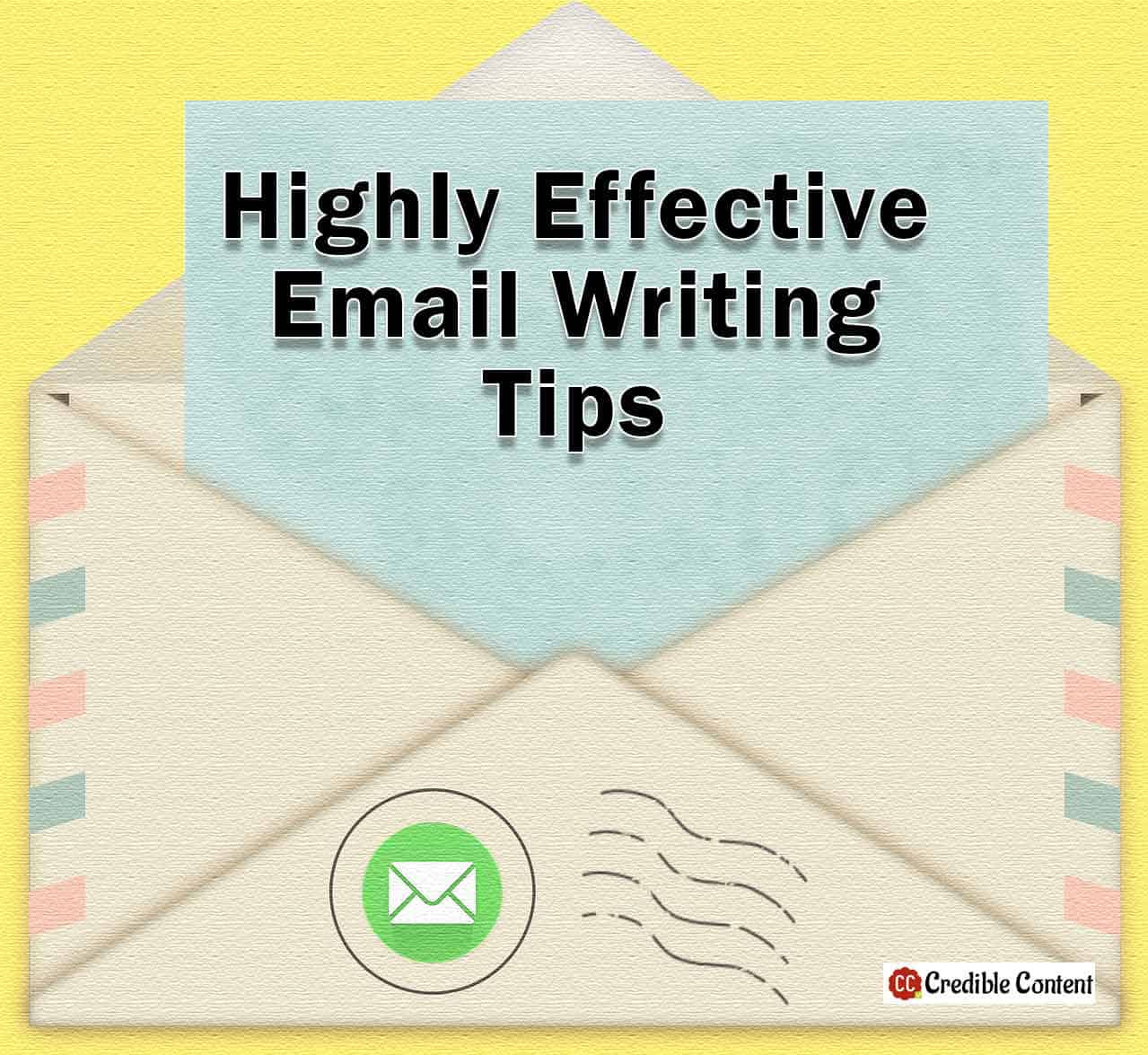
Highly effective email writing tips.
You use emails every day. You use them in your office. You use them for email marketing. Students and teachers these days are heavily using emails to communicate with each other.
How to make your email writing effective?
You make your email writing effectively by
- Writing clear-cut subject lines.
- Using the opening sentence convincingly.
- Using personal greetings instead of nameless greetings.
- Identifying yourself clearly.
- Keeping your message short and crisp.
- Proofreading your email writing multiple times.
- Being regular with your email writing.
- Not bombarding the recipients with too many messages.
- Keeping your messages scannable and easy to read quickly.
- Avoiding using too friendly a tone.
- Briefly introducing yourself if people don’t know you.
- Avoiding sending one-liners.
- Avoiding words in your subject line that can get you marked as a spammer.
- Always having a “why” for sending out the email message.
- Avoiding clichés and hackneyed words and expressions.
- Not forgetting to include call to action.
Since email is used for communication, and since you are not present in front of the person, your email message must accomplish the entire job of communicating effectively and convincingly.
You may like to check out Pro-email writing services for your everyday email writing needs.
Here are 10 highly effective email writing tips you can use to make sure that your email is delivered the message you want them to deliver.
1. Write a clear-cut subject line
You do not have to bother with the subject line if you are writing to your relatives or friends because they are anyway going to open your email.
Your subject line matters when you’re sending emails to people who may not open your message because their priorities are different or maybe they are distracted or they are totally indifferent towards your email.
In such a case scenario, it is very important to write an unambiguous subject line. Clearly state what is inside the email message and what is the purpose of your message.
Keep your subject line short and succinct. Make it convincing if it is a marketing message.
Avoid using spammy words.
2. Use a convincing first sentence
Your first sentence is going to decide if people are going to read your message. Make it as convincing as possible.
How do you write a convincing first sentence? Address the problem that your email intends to solve or mention the issue your email intends to raise.
Cut to the chase.
3. Use a personal greeting
“Hello Sophie” or “Dear Sophie” is much better than “Hey there!” or “Dear friend”.
Of course, if you don’t know the name of the person you can’t use his or her name. All the more necessary that when you are sending out emails, at least know their names.
4. Identify yourself clearly
Identifying yourself clearly solves many purposes. Even if people know you and they would open your message no matter what you write, they may inadvertently miss it simply because you fail to identify yourself clearly.
Although this is less to do with writing and more to do with your email setting, if people can clearly see “From Amrit Hallan” there will be a better chance of them opening the message because they will know that the message is coming from an awesome content writer.
If they remotely remember you it will help them recognize your name and if they associate your name with a product or a service or some brand and if they want to receive messages about that product or service or brand, your name will prompt them to open your message.
You may also like to read Define your brand voice with quality content writing.
5. Keep your message short
Writing short messages is a very important part of writing effective emails. These days most of your recipients open your messages on their mobile phones and on mobile phones, often it is difficult to read and comprehend long messages.
Even if you are sure that most of your audience constitutes of people who use computers and laptops, it is better to keep your messages short and focused.
This way your readers don’t get distracted.
6. Proofread multiple times
In the times of social media, the quality of writing has drastically deteriorated. It is often stressed that it is not the quality of your writing but the message that counts.
While this may be true when you are writing among your friends and relatives, when it comes to writing professional emails or even among your colleagues and co-workers, how you write and what is the quality of your writing matter a lot.
Your prospective customer may think that if you don’t even care about how you write, how are you going to care about your customers?
Typos and spelling and grammar mistakes reek of carelessness and disrespect.
Hence, proofread your email message after writing initially, multiple times.
7. Be regular with your email writing
This is for those who want to carry out email marketing campaigns. You can carry out highly effective email marketing campaigns if your recipients are familiar with your messages.
Although many people say that “familiarity breeds contempt”, it also breeds a kinship if you become a regular part of people’s lives.
Regularly send them useful information they can benefit from.
Always be sincere.
Remember that when you’re sending out emails, it is for the benefit of the recipients. Even if in the process you are increasing your business, ultimately, people will be receptive to your messages if you can convince them you’re sending them for their sake and not your sake.
Having said that, regularity can be very effective.
8. Don’t bombard them with messages
Just as writing emails regularly can be effective, going overboard can be counter-productive and may end up annoying the recipients.
Usually, one message every day is more than enough. If you can keep them a couple of times in a week, even better.
This is for regular email marketing. If you simply need to communicate regularly with your office colleagues then frequency doesn’t matter, it is always need-based.
9. Keep your messages scannable
Sometimes you can’t help writing longer email messages. If this is the case, you can make it easier for your recipients to read them by making them scannable.
What does writing scannable email messages mean?
Use headings and subheadings to highlight important points.
Use bulleted lists of very short sentences to sum up the main points.
Write one sentence per paragraph.
If formatting is possible, you can even use different colors to highlight different messages, but then, don’t overdo it.
10. Avoid using too friendly a tone
Being extra friendly in your email messages may creep some people out, especially if you’re not close enough to them. You can use whatever tone you feel like when you are writing to friends and family, but when you are writing to your colleagues you need to be a little less informal.
11. Introduce yourself if people don’t know you
Don’t just assume that they are familiar with you.
Although if you’re sending multiple messages you can’t be introducing yourself in complete detail in every message because this may turn off people who check your messages regularly, a one-liner about what you do and what you can deliver can go a long way in keeping people interested in you and developing a sense of familiarity.
12. Avoid sending one-liners
Email clients like Gmail these days allow you to send one-liners by suggesting what to type.
Although these suggestions help you respond quickly especially when conversations are happening in real time, if it has been a few hours since your last communication or the message you are replying to was sent a couple of days ago, write complete sentences so that the recipient can recall what you are writing about. Don’t simply reply with a “Thanks” or a “fine”.
13. Avoid words in the subject line that can get you mistaken for spam
Using all-caps can get you marked as a spammer by email services like Gmail and even Outlook. Expressions like “Earn money” or “Make money” or the dollar sign, can send your message directly to the spam folder.
14. Always have a strong “why” behind why you are writing
Want to give people a reason to open and read your email messages? Then include a strong “why” behind why they should read or pay attention to your message. Give them a compelling reason.
15. Avoid using clichés
Clichés are the common expressions that either we get too used to writing in our email messages and we don’t even realize, or sometimes we use them to sound uber and cool.
For example, whenever I am sending a completed document to my clients I simply write “PFA”. I don’t even write “Please find attached”. Although I do it with my regular clients and not with my recently acquired clients, if possible, you should avoid clichés such as
- Thank you in advance.
- I look forward to hearing from you.
- As per our conversation.
- To whom it may concern.
- Sorry for the late reply.
16. Don’t forget to use call to action
Your “call to action” is the action you want people to perform when they have gone through your email message.
If you want them to buy from you, use “buy now”. If you want them to click a link and download your e-book, specifically mention “download my e-book”. If you want them to contact you, write “contact me now”.
It may seem strange, sometimes people don’t perform the action you want them to perform because you haven’t asked them to.
Concluding remarks
Frankly, to be able to write highly effective emails, you must have a compelling reason to write. People are too busy these days.
Although it is fine to write emails just to keep in touch, when you don’t know them personally, it is always better to write when you have something really valuable to offer.
In most of the cases, when you are convincing, when you are excited about what you are communicating, even with little effort you can write highly effective emails.


